Popular actress and singer Renate Müller (1906-1937) was the toast of late 1920s Berlin. She had a comet-like career in the early German sound cinema, which was abruptly ended by her mysterious death at the age of 31.

German postcard by Ross Verlag, no. 7867/1, 1932-1933. Photo: Ufa.
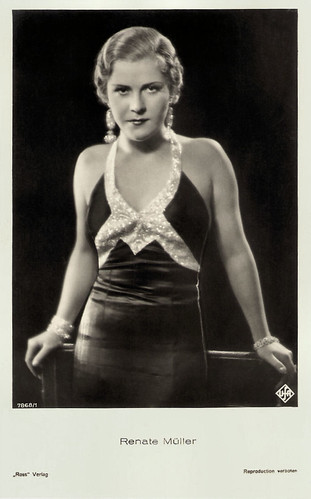 German postcard by Ross Verlag, no. 7868/1, 1932-1933. Photo: Ufa
German postcard by Ross Verlag, no. 7868/1, 1932-1933. Photo: Ufa

German postcard by Ross Verlag, no. 8751/2, 1933-1934. Photo: Atelier Schenker, Berlin.
Renate Müller was born in Munich, Germany, in 1906. Her father was one of Munich's leading newspaper publishers.
She was trained as a singer and a stage actress at the Max Reinhardt theatre school. Famous director G.W. Pabst reportedly gave her lessons there.
She started acting on stage in the second half of the 1920's, at the Berlin Lessing Theater, and played opposite famous actor Alexander Moissi on-stage in Zweimal Oliver/Oliver Twice.
A blue-eyed blonde, she was considered to be one of the great beauties of her day. Director Reinhold Schünzel let her make her film debut with the comedy Peter, der Matrose/Peter the Sailor (1929).
That was still a silent film, but Müller would soon flourish in the German sound film, for which her well-trained voice came in handy. She played in the German version of Italy's first sound film, Gennaro Righelli's La canzone dell'amore, Liebeslied/Love Song (Constantin J. David, 1931) with Gustav Fröhlich.
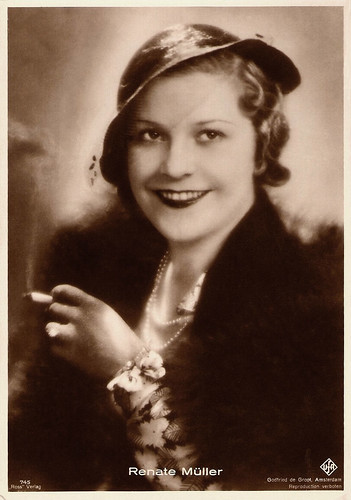
German postcard by Ross Verlag, no. 745. Photo: Godfried de Groot, Amsterdam.
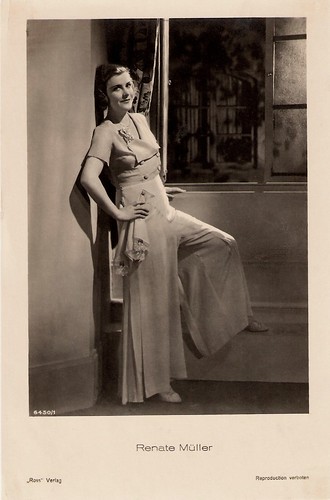
German postcard by Ross Verlag, no. 6450/1, 1931-1932.

German postcard by Ross Verlag, no. 7278/3, 1932-1933. Photo: Ufa.

German postcard by Ross Verlag, no. 8113/1, 1933-1934. Photo: Ufa / Atelier Jacobi, Berlin.
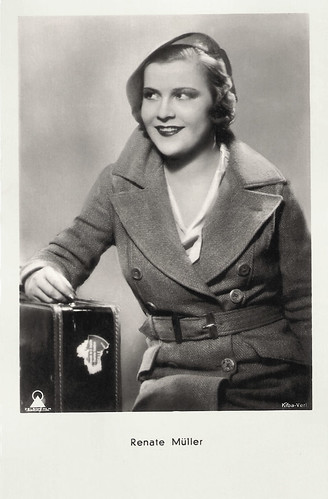
Austrian postcard by Iris Verlag / Amag, no. 6497. Photo: Felsom-Film / Kiba-Verleih.
Renate Müller played often the natural, self-conscious young woman who knows what she wants, opposing the sweet girls and vamps of the 1920s. And thus we see her in films such as the singing secretary in Die Privatsekretärin/Private Secretary (Wilhelm Thiele, 1931), of which her song Ich bin ja heut' so glücklich became a smash hit.
In the simultaneously made English version, Sunshine Susie (Victor Saville, 1932), Müller also starred, and now she sang Today I am so happy.
There were also a French version, Dactylo, with Marie Glory, and an Italian version, La segretaria privata, with Elsa Merlini who sang Oh come son' felice, felice, felice.
At AllMovie, Hans J. Wollstein writes: "The ultimately tragic Renate Müller blazed onto international screens in Die Privatesekretärin (The Private Secretary, 1931), a sort of Germanic Joan Crawford getting by in a man's world on her wits and a pair of shapely legs. The comedy was so popular that Müller also made an English-language version featuring popular U.K. star Owen Nares."

Dutch postcard by JosPe, no. 457. Photo: Godfried de Groot, Amsterdam.
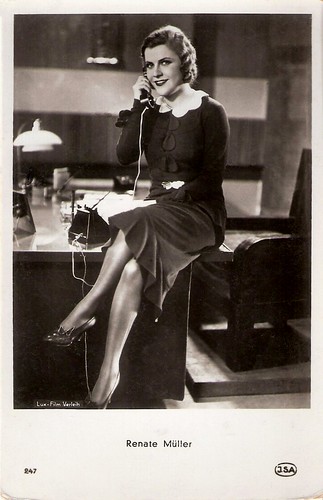
Dutch postcard by J.S.A., no. 247. Photo: Lux-Film Verleih. Still from Die Privatsekretärin/Private Secretary (Wilhelm Thiele, 1931).

Dutch postcard by JosPe, no. 336. Photo: City Film. Publicity still from Die Privatsekretärin/The Private Secretary (Wilhelm Thiele, 1931) with Hermann Thimig.
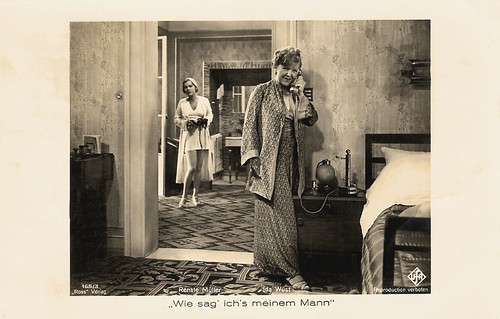
German postcard by Ross Verlag, no. 165/3, 1932-1933. Photo: Ufa. Publicity still for Wie sag' ich's meinem Mann?/How Shall I Tell My Husband? (Reinhold Schünzel, 1932) with Ida Wüst.

German postcard by Ross Verlag, no. 195/1. Photo: Ufa. Publicity still for Viktor und Viktoria/Viktor and Viktoria (Reinhold Schünzel, 1933) with Hermann Thimig.
Reinhold Schünzel directed Renate Müller in 8 of her 26 films. He is one of the most badly neglected directors of the German pre-war cinema. This is probably caused by the fact that he received the status of an 'Ehrenarier' during the Third Reich.
Schünzel gave valuable impulses for the German cinema. He was successful as an actor as well as a director, writer and producer. Already in 1918 he directed his first film.
Schünzel developed into a crowd-puller in the sound film era with comedies like Saison in Kairo/Cairo Season (1933), Viktor und Viktoria (1933) and Die englische Heirat/The English Marriage (1934), all starring Renate Müller.
Viktor und Viktoria (1933) with Müller as a female vaudeville artist dressing up as a man, was the highlight. It is even wittier than the famous Julie Andrews version, Victor Victoria (Blake Andrews, 1981).
But work became more and more difficult for Schünzel because of the Third Reich, and as a half-Jew he depended on a work permit for each further film. His success protected him, and in 1935 he shot the most successful film of the year - Amphytrion starring Willy Fritsch.
But already in 1937 there were so many interventions in his films that he left the country for the USA directly after finishing Land der Liebe/Land of Love (1937).

German postcard by Ross Verlag, no. 7874/1, 1932-1933. Photo: Ufa. Publicity still for Saison in Kairo/Cairo Season (Reinhold Schünze, 1933l), starring Renate Müller and Willy Fritsch.
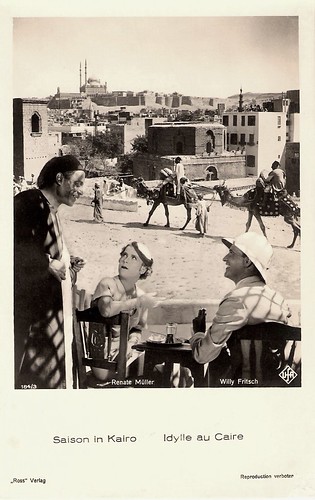
German postcard by Ross Verlag, no. 104/3. Photo: Ufa. Still from Saison in Kairo/Cairo Season (1933).
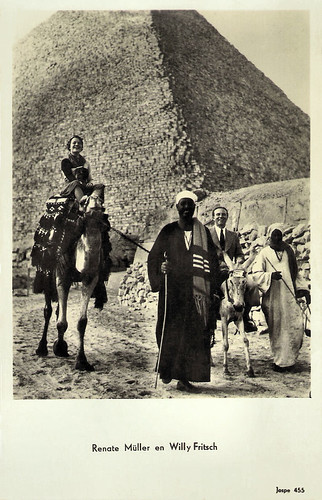
Dutch postcard by JosPe, no. 455. Photo: publicity still for the musical comedy Saison in Cairo/Season in Cairo (Reinhold Schünzel, 1933).
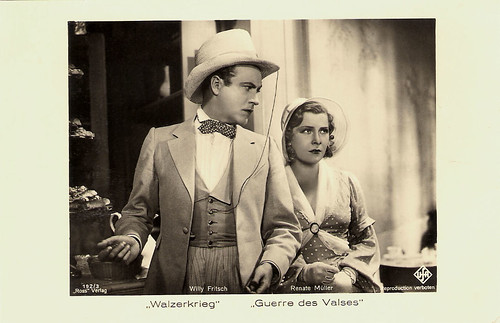
German postcard by Ross Verlag, no. 192/3, 1932-1933. Photo: Ufa. Publicity still for Walzerkrieg/Waltz Time in Vienna (Ludwig Berger, 1933) with Willy Fritsch. Collection: Egbert Barten.
With the rise of the Nazi Party, Renate Müller came to be regarded as an ideal Aryan woman and particularly in the light of Marlene Dietrich's move to Hollywood, she was courted and promoted as Germany's leading film actress.
According to Wikipedia, a meeting with Adolf Hitler resulted in Müller being offered parts in films that promoted Nazi ideals.
After a breakdown in 1933, she had to stop filming in 1934 because of a serious disease, probably epilepsy. Afterwards she only did sporadic performances. Wikipedia notes that she was also known to have been pressured to end a relationship with her Jewish lover, but had refused.
Hans J. Wollstein writes at AllMovie that she finally gave in to the pressure of the Nazis, starring in the blatantly anti-Semitic Togger (1937). The situation made her a nervous wreck and in October 1937 she checked into a clinic, ostensibly for treatment of a knee injury. She never returned.
When she suddenly died on 10 October 1937, the German press stated the cause as epilepsy, but witnesses recalled seeing several Gestapo officers entering her building shortly before she died.
Her death proved a public relations disaster for the regime in general and for propaganda minister Goebbels in particular. To counteract the public's negative reactions, the ministry of propaganda spread rumors that she had become addicted to morphine, that she was an alcoholic and mentally disturbed.
Her life story later was filmed as Liebling der Götter/Darling of the Gods (Gottfried Reinhardt, 1960), with Ruth Leuwerik playing Renate.
According to the British TV documentary Sex and the Swastika (2009), Renate jumped from a window in the Berlin mental home. Wikipedia states that it has been asserted she was either murdered by Gestapo officers who threw her from a window, or that she panicked when she saw them arrive and jumped. The true circumstances surrounding her death remain unclear.

Dutch postcard, for the Dutch release of Walzerkrieg/The Battle of the Walzes (Ludwig Berger, 1933). Photo: Ufa.

German postcard by Ross Verlag, no. 8112/3, 1933-1934. Photo: Ufa.

German postcard by Ross Verlag, no. 8113/1, 1933-1934. Photo: Ufa / Atelier Jacobi, Berlin.
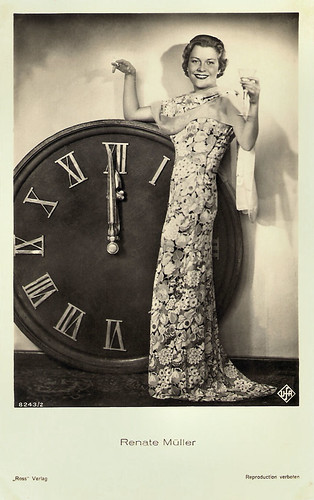
German postcard by Ross Verlag, no. 8243/2, 1933-1934. Photo: Ufa.
Renate Müller sings Today I Feel so happy in Sunshine Susie (1932). Source: Alparfan (YouTube).
Sources: Hans J. Wollstein (AllMovie), Thomas Staedeli (Cyranos), Filmportal.de, Wikipedia and IMDb.

German postcard by Ross Verlag, no. 7867/1, 1932-1933. Photo: Ufa.
 German postcard by Ross Verlag, no. 7868/1, 1932-1933. Photo: Ufa
German postcard by Ross Verlag, no. 7868/1, 1932-1933. Photo: Ufa
German postcard by Ross Verlag, no. 8751/2, 1933-1934. Photo: Atelier Schenker, Berlin.
Well-Trained Voice
Renate Müller was born in Munich, Germany, in 1906. Her father was one of Munich's leading newspaper publishers.
She was trained as a singer and a stage actress at the Max Reinhardt theatre school. Famous director G.W. Pabst reportedly gave her lessons there.
She started acting on stage in the second half of the 1920's, at the Berlin Lessing Theater, and played opposite famous actor Alexander Moissi on-stage in Zweimal Oliver/Oliver Twice.
A blue-eyed blonde, she was considered to be one of the great beauties of her day. Director Reinhold Schünzel let her make her film debut with the comedy Peter, der Matrose/Peter the Sailor (1929).
That was still a silent film, but Müller would soon flourish in the German sound film, for which her well-trained voice came in handy. She played in the German version of Italy's first sound film, Gennaro Righelli's La canzone dell'amore, Liebeslied/Love Song (Constantin J. David, 1931) with Gustav Fröhlich.

German postcard by Ross Verlag, no. 745. Photo: Godfried de Groot, Amsterdam.

German postcard by Ross Verlag, no. 6450/1, 1931-1932.

German postcard by Ross Verlag, no. 7278/3, 1932-1933. Photo: Ufa.

German postcard by Ross Verlag, no. 8113/1, 1933-1934. Photo: Ufa / Atelier Jacobi, Berlin.

Austrian postcard by Iris Verlag / Amag, no. 6497. Photo: Felsom-Film / Kiba-Verleih.
Natural and Self-conscious Woman
Renate Müller played often the natural, self-conscious young woman who knows what she wants, opposing the sweet girls and vamps of the 1920s. And thus we see her in films such as the singing secretary in Die Privatsekretärin/Private Secretary (Wilhelm Thiele, 1931), of which her song Ich bin ja heut' so glücklich became a smash hit.
In the simultaneously made English version, Sunshine Susie (Victor Saville, 1932), Müller also starred, and now she sang Today I am so happy.
There were also a French version, Dactylo, with Marie Glory, and an Italian version, La segretaria privata, with Elsa Merlini who sang Oh come son' felice, felice, felice.
At AllMovie, Hans J. Wollstein writes: "The ultimately tragic Renate Müller blazed onto international screens in Die Privatesekretärin (The Private Secretary, 1931), a sort of Germanic Joan Crawford getting by in a man's world on her wits and a pair of shapely legs. The comedy was so popular that Müller also made an English-language version featuring popular U.K. star Owen Nares."

Dutch postcard by JosPe, no. 457. Photo: Godfried de Groot, Amsterdam.

Dutch postcard by J.S.A., no. 247. Photo: Lux-Film Verleih. Still from Die Privatsekretärin/Private Secretary (Wilhelm Thiele, 1931).

Dutch postcard by JosPe, no. 336. Photo: City Film. Publicity still from Die Privatsekretärin/The Private Secretary (Wilhelm Thiele, 1931) with Hermann Thimig.

German postcard by Ross Verlag, no. 165/3, 1932-1933. Photo: Ufa. Publicity still for Wie sag' ich's meinem Mann?/How Shall I Tell My Husband? (Reinhold Schünzel, 1932) with Ida Wüst.

German postcard by Ross Verlag, no. 195/1. Photo: Ufa. Publicity still for Viktor und Viktoria/Viktor and Viktoria (Reinhold Schünzel, 1933) with Hermann Thimig.
Reinhold Schünzel
Reinhold Schünzel directed Renate Müller in 8 of her 26 films. He is one of the most badly neglected directors of the German pre-war cinema. This is probably caused by the fact that he received the status of an 'Ehrenarier' during the Third Reich.
Schünzel gave valuable impulses for the German cinema. He was successful as an actor as well as a director, writer and producer. Already in 1918 he directed his first film.
Schünzel developed into a crowd-puller in the sound film era with comedies like Saison in Kairo/Cairo Season (1933), Viktor und Viktoria (1933) and Die englische Heirat/The English Marriage (1934), all starring Renate Müller.
Viktor und Viktoria (1933) with Müller as a female vaudeville artist dressing up as a man, was the highlight. It is even wittier than the famous Julie Andrews version, Victor Victoria (Blake Andrews, 1981).
But work became more and more difficult for Schünzel because of the Third Reich, and as a half-Jew he depended on a work permit for each further film. His success protected him, and in 1935 he shot the most successful film of the year - Amphytrion starring Willy Fritsch.
But already in 1937 there were so many interventions in his films that he left the country for the USA directly after finishing Land der Liebe/Land of Love (1937).

German postcard by Ross Verlag, no. 7874/1, 1932-1933. Photo: Ufa. Publicity still for Saison in Kairo/Cairo Season (Reinhold Schünze, 1933l), starring Renate Müller and Willy Fritsch.

German postcard by Ross Verlag, no. 104/3. Photo: Ufa. Still from Saison in Kairo/Cairo Season (1933).

Dutch postcard by JosPe, no. 455. Photo: publicity still for the musical comedy Saison in Cairo/Season in Cairo (Reinhold Schünzel, 1933).

German postcard by Ross Verlag, no. 192/3, 1932-1933. Photo: Ufa. Publicity still for Walzerkrieg/Waltz Time in Vienna (Ludwig Berger, 1933) with Willy Fritsch. Collection: Egbert Barten.
The True Circumstances
With the rise of the Nazi Party, Renate Müller came to be regarded as an ideal Aryan woman and particularly in the light of Marlene Dietrich's move to Hollywood, she was courted and promoted as Germany's leading film actress.
According to Wikipedia, a meeting with Adolf Hitler resulted in Müller being offered parts in films that promoted Nazi ideals.
After a breakdown in 1933, she had to stop filming in 1934 because of a serious disease, probably epilepsy. Afterwards she only did sporadic performances. Wikipedia notes that she was also known to have been pressured to end a relationship with her Jewish lover, but had refused.
Hans J. Wollstein writes at AllMovie that she finally gave in to the pressure of the Nazis, starring in the blatantly anti-Semitic Togger (1937). The situation made her a nervous wreck and in October 1937 she checked into a clinic, ostensibly for treatment of a knee injury. She never returned.
When she suddenly died on 10 October 1937, the German press stated the cause as epilepsy, but witnesses recalled seeing several Gestapo officers entering her building shortly before she died.
Her death proved a public relations disaster for the regime in general and for propaganda minister Goebbels in particular. To counteract the public's negative reactions, the ministry of propaganda spread rumors that she had become addicted to morphine, that she was an alcoholic and mentally disturbed.
Her life story later was filmed as Liebling der Götter/Darling of the Gods (Gottfried Reinhardt, 1960), with Ruth Leuwerik playing Renate.
According to the British TV documentary Sex and the Swastika (2009), Renate jumped from a window in the Berlin mental home. Wikipedia states that it has been asserted she was either murdered by Gestapo officers who threw her from a window, or that she panicked when she saw them arrive and jumped. The true circumstances surrounding her death remain unclear.

Dutch postcard, for the Dutch release of Walzerkrieg/The Battle of the Walzes (Ludwig Berger, 1933). Photo: Ufa.

German postcard by Ross Verlag, no. 8112/3, 1933-1934. Photo: Ufa.

German postcard by Ross Verlag, no. 8113/1, 1933-1934. Photo: Ufa / Atelier Jacobi, Berlin.

German postcard by Ross Verlag, no. 8243/2, 1933-1934. Photo: Ufa.
Renate Müller sings Today I Feel so happy in Sunshine Susie (1932). Source: Alparfan (YouTube).
Sources: Hans J. Wollstein (AllMovie), Thomas Staedeli (Cyranos), Filmportal.de, Wikipedia and IMDb.
No comments:
Post a Comment